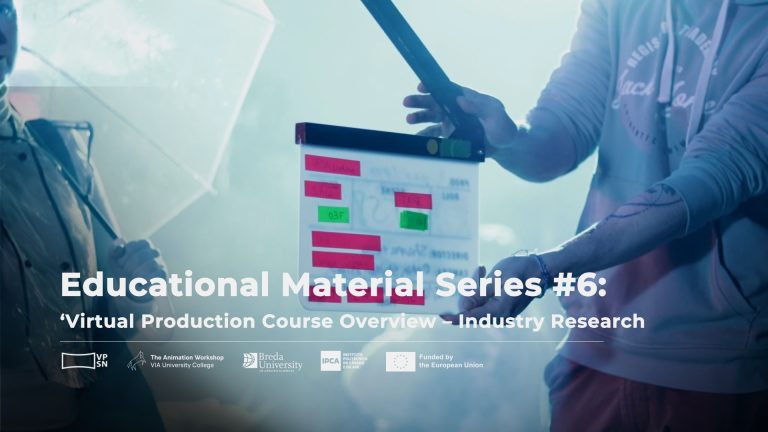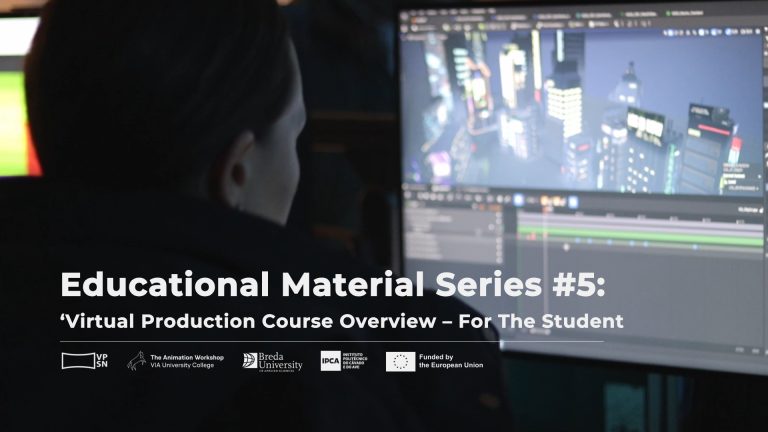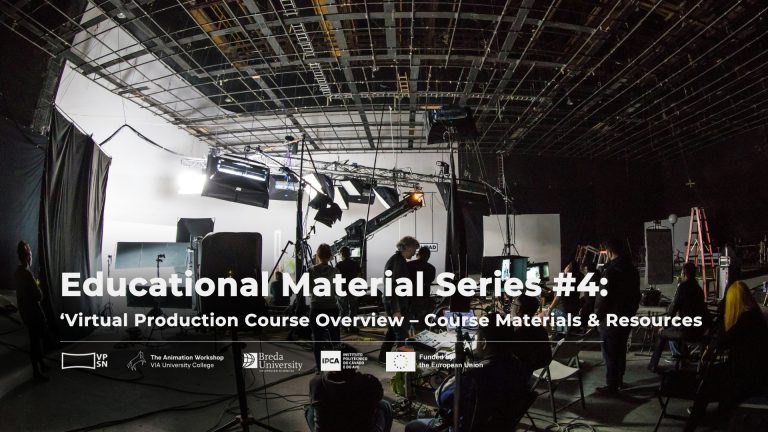
Carlos Pereira Santos
Professor, R&D Coordinator, Senior Lecturer and AI/Games/Media Specialist at Breda University of Applied Sciences
We had the opportunity to sit down with Carlos Santos, R&D Coordinator at Breda University of Applied Sciences, to discuss the growing field of virtual production (VP) and its impact on European filmmaking.
While virtual production technology brings exciting possibilities – like real-time scene visualization, expansive virtual sets, and more accessible production capabilities – it also presents obstacles, from high setup costs to a lack of experienced professionals. Carlos offers insight into how traditional production roles are evolving, where new skills are needed, and how the challenges of training the next generation of filmmakers are being tackled through innovative educational programs.
In this interview, Carlos discusses these opportunities and hurdles, touching on topics like the integration of VP into the university curriculum, the role of industry collaboration in hands-on learning, and the broader implications of virtual production for creativity and diversity in storytelling across Europe.
Q: What is your current occupation and your experience with the VP?
My current occupation is research and development coordinator in Breda Applied science University and I’m one of the researchers that are linked with studying the virtual productions and how is VP techniques and technology affecting productions and reproductions and the way films are made.
Q: How well established is virtual production in your region and in Europe?
Virtual production technology is still in its early stages and lacks widespread understanding and expertise. While it offers clear advantages, its full potential has yet to be realized due to challenges in implementation. Despite initial hype and investment in XR stages or LED volumes by some studios, the excessive costs associated with virtual production have hindered widespread adoption. The investment has been huge and now they are looking at how to get their investments back. As more studios enter the market and technical skills develop, costs may decrease, making virtual production more accessible. Currently, the industry faces challenges not only with virtual production but also with broader film production issues. Additionally, there are emerging concerns about the implications of AI on production processes, a topic that will likely be explored further in the coming years.
Q: What new roles or adaptations to existing roles, do you think, are necessary within a Virtual Production Studio project? Can you outline what these new roles involve?
New roles in virtual production often complement existing ones, requiring clarity and collaboration. For example, production designers must now work with virtual production designers to blend real and virtual environments, while technical roles focus on managing LED walls, camera tracking, and equipment setup. Traditional roles, like the Director of Photography and gaffer, may also evolve to balance digital and physical lighting and camera needs, emphasizing teamwork between classic film roles and digital specialists for a seamless final product.
Q: How do you think virtual production technology can or has changed the approach to the production pipeline?
Virtual production (VP) goes beyond LED volume setups, using real-time tech to streamline production from pre-production, allowing filmmakers to visualize and adjust scenes early. VP reduces reliance on a single vision, enhances predictability, and enables collaborative risk assessment, making complex productions, particularly in budget-constrained regions like Europe, more feasible. VP opens doors for ambitious, historically challenging productions, giving creators with limited resources access to elaborate virtual sets, and leveling the field between European and American filmmaking. This democratization empowers diverse creators, broadens genre exploration, and expands distribution options, pushing storytelling boundaries in exciting new ways.
Q: What opportunities and challenges does virtual production present?
Virtual Production (VP) offers a global opportunity to boost technical skills, with the U.S. leading in adoption and training, though other regions have the potential to catch up through events and collaborative projects. Despite initial cost and technology access challenges, VP is becoming more affordable, and a growing pool of skilled professionals helps ease entry barriers. Knowledge-sharing hesitations due to competition are gradually changing, and as more diverse technical backgrounds emerge, VP will benefit from innovation through competing software and fresh approaches, furthering industry growth.
Q: What other barriers do you consider there to be greater access to facilities and training for virtual production?
Virtual production (VP) studios are expanding, with new facilities in places like the Netherlands, Belgium, and Germany, including setups by universities and rental companies. While interest in VP grows, challenges remain in scaling technical skills and facilities, alongside high setup costs, limited technical staff, and location choice. Despite these, early adopters are paving the way with training programs, setting an example for broader adoption. Economic factors, from global supply chain issues to geopolitical events, could impact VP, emphasizing the need for resilience in an evolving industry sensitive to broader economic trends.
Q: What are current VP practices in education in Europe or in your region? At Breda University, do you have any planned changes for the future regarding education and training?
We began integrating virtual production (VP) through extra-curricular activities, moving to full-credit courses as we gained confidence, and now offer a dedicated VFX program with semesters focused on VP. Looking ahead, we plan to introduce specialized Master’s programs to explore technical roles and market innovations, and we maintain active industry workshops to keep pace with field advancements. This gradual curriculum integration and industry collaboration prepares students for the evolving demands of VP.
Q: What advice could you give to educational institutions without access to their VP studio?
Each university has unique needs, so collaboration is essential to advancing virtual production (VP). By advising and training staff at other institutions and hosting events like the VP Gathering, we help build a shared knowledge base, which enhances opportunities for students and industry alike. Access to VP tools like LED walls can start small—using green screens or sharing facilities—then grow as demand rises. With our LED volume fully booked for classes, research, and events, we’ve seen firsthand how valuable investing in these resources can be, providing endless opportunities for creative and educational experiences.
Q: So what do you think are the biggest challenges when teaching students VP and what would be your suggestions for the future to overcome them?
The primary challenge in education is that virtual production technology is still new, making it difficult to teach effectively. We use both traditional and hands-on approaches, but each production presents unique learning opportunities, forcing us to problem-solve in real-time rather than relying on textbooks. While this method benefits students by developing their practical skills, the uncertainty and evolving nature of the technology can be daunting for instructors, who may struggle to provide definitive answers. As the technology matures, we may transition to more traditional teaching methods, but current conditions require adaptability and innovation.
Q: With technology changing so fast, what challenges do you face updating the training materials to facilitate the market needs?
For instance, with emerging technologies like Gaussian splatting, we face a choice: wait for the technology to mature before teaching it or experiment alongside students, acknowledging our lack of experience. While this hands-on approach fosters learning, it risks producing subpar results. Conversely, teaching only established techniques ensures accuracy but may lag behind industry advancements. Balancing foundational knowledge with new technologies is challenging, as both are rapidly evolving. Our responsibility lies in determining the essential skills to include in the curriculum while adapting to these changes. This constant cycle of teaching and learning can be chaotic, especially with the anticipated impact of AI on the industry.
Q: What possible ways industry could help or support educational institutions regarding preparing students to work with VP?
Case studies would be beneficial, whether they showcase their own projects or share insights on what they did, as this creates a link between what they are describing and what students are learning. Additionally, testing scenarios from upcoming productions involving difficult challenges can inspire students to investigate, explore, and even fail, which is acceptable since it’s based on real industry cases. This feedback loop is crucial for the industry to showcase and present use cases.
However, I understand that the fast pace of the industry often leaves little time for collaboration with universities. When industry professionals approach us with a project and request student involvement, they often need quick results that don’t align with academic timelines. To be effective, these collaborations need to be integrated into the curriculum, starting at the beginning of the semester and concluding by the end. If industry partners can share their knowledge and project experiences, it would foster a closer connection with the studio and make this type of work more feasible.



